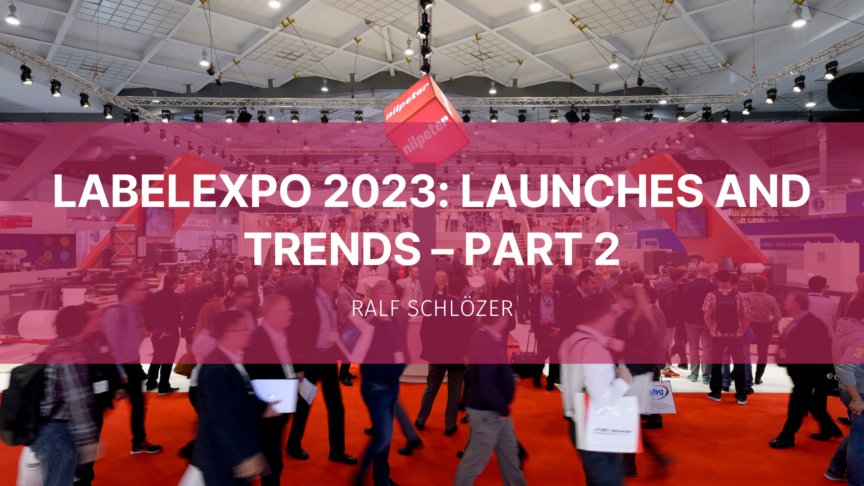This is part two of the report on news and trends at LabelExpo Europe 2023. The first part covered standalone and hybrid inkjet label presses but announcements at LabelExpo were not limited to presses. Several interesting launches in ancillary processes such as embellishment, finishing, inks and process control for label production were made as well and we cover them here.
Process control
Durst unveiled the Hawk Eye system, based on computer vision and artificial intelligence. At the show, most details of a new technology announced in May were finally made public. Like other quality control and nozzle-health-monitoring systems, the Hawk Eye is designed to assist operators and automate print quality. In addition, it significantly reduces set-up time and waste, resulting in enhanced efficiency and lower cost.
The Hawk Eye technology has some twists: image defects are detected in the image and there is no need for test patterns or colour bars. There is usually no PDF or “golden image” needed to detect the defects (although in some cases it might be needed. Durst was not too specific here). This simplifies set-up and allows the system to run in the background. Hawk Eye can also exactly identify the defective nozzle, the prerequisite for automatic compensation. The Durst Hawk Eye itself includes a scanner system, workstation, and touch screen monitor.
Tests have been run at 80 m/min, with 100 m/min, the full speed of the RSCi, to follow soon. The calculation loop takes a bit of time, meaning that compensation kicks in after 15 metres of print at full speed, although Durst plans to bring the time down. The system is at two beta sites at the moment. Full availability is planned for 2024.
The technology has been developed by Covision Lab, a start-up company for computer vision and machine learning with the Durst owner as a major investor. Since parts of the technology are still being patented, Durst did not want to comment on all details.
A big advantage is that operators do not need to complete any set-up and there is no need to print a special test pattern. Most vendors of high-speed inkjet presses offer some form of nozzle health check systems today. The Hawk Eye promises to make the process even easier and more automated. It will be interesting to get feedback from the first customers. Unfortunately, Durst did not comment on pricing, which will be an important factor in whether the technology is going to be adopted widely.
The Hawk Eye technology has been introduced for the Tau RSC platform printers, including the hybrid press with partner Omet. It is also retrofittable to presses not older than five years. Durst’s plans for the Hawk Eye system do not stop there, however. As a scalable technology, the system could be introduced into the folding carton or corrugated presses of the Koenig & Bauer joint venture or other future single-pass inkjet presses.
Embellishment
Embellishment remained a hot topic in recent years. There are a number of established suppliers to the industry by now and solutions are getting further refined. Inkjet continues to play a major role.
At Labelexpo JetFx showed their inkjet imprinting bars in several booths. There were some improvements like food packaging compliant coatings in both EB and UV categories, a newly developed security feature, and the JetFx visualizer – a 3-D visualization software that enables customers to see JetFx embellishments before print. MGI introduced a new embellishing product: the Jetvarnish 3D Web Compact. With two inkjet engines, the new device can apply UV varnish and hot foil at the same time. German graphic industry supplier PrintsPaul presented a low-cost narrow-web foiling system based on UV inkjet. Grafisk Maskinfabrik (GM) showcased the latest version of their ultra-compact GM DVM 350 digital varnish module, which can be used for foiling as well.
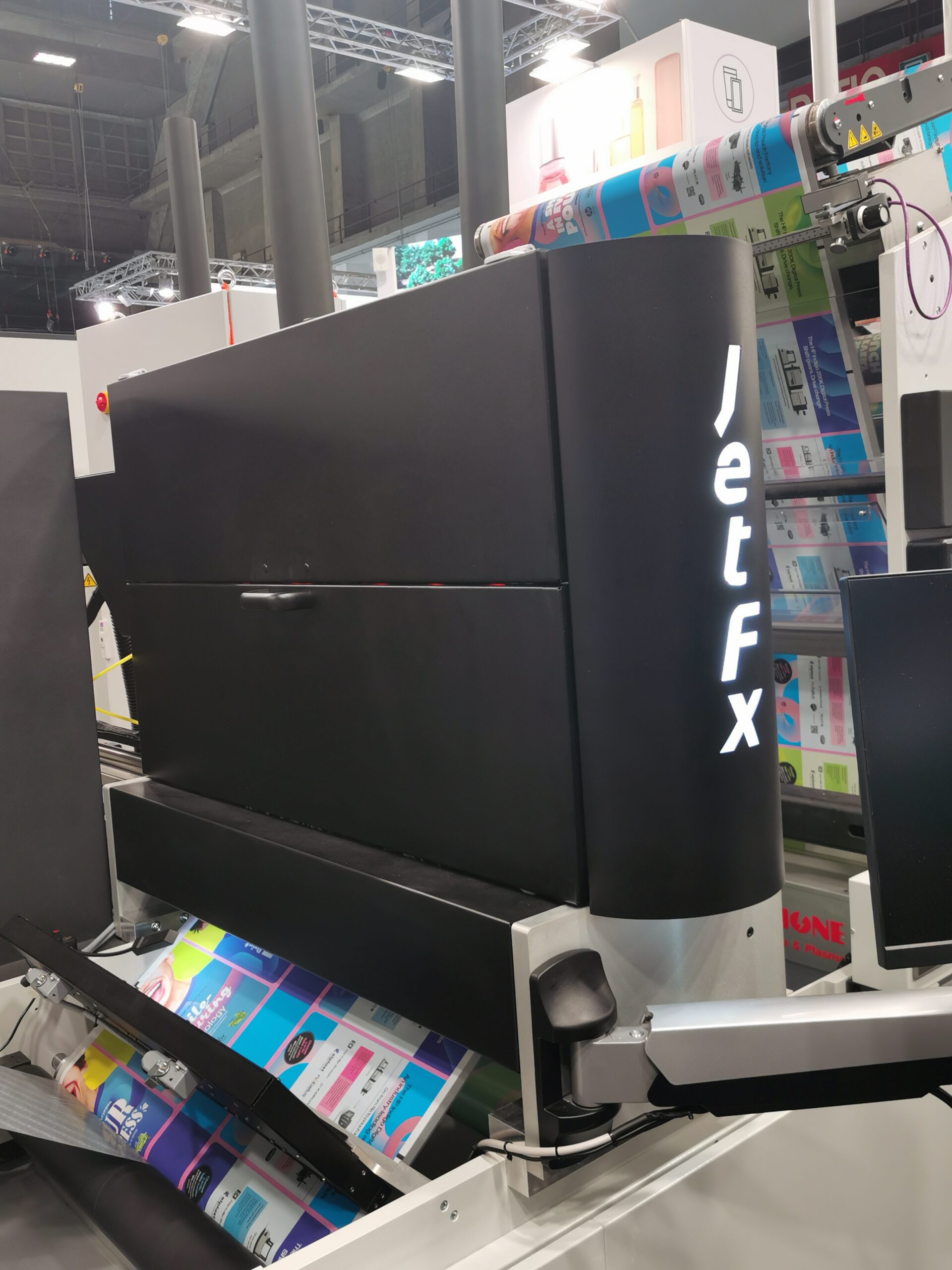
JetFx inkjet embellishment bar
Another development, from Actega, warrants a special mention, although the Ecoleaf technology has been previewed several times before. Actega is part of the Altana Group, a major industry supplier of inks and materials. By introducing the Ecoleaf technology the company is now taking on hardware as well to provide a complete solution. The Ecoleaf technology has been discussed before, just as a short recap: it relies on creating a mono-layer of small metal flakes and making them stick to a pre-printed trigger image. The advantages are obvious: instead of heaps of foil just a small amount of flakes is needed. The technology is now fully released. Actega is offering two types of metallisation modules: One for integration into printing presses, the other a standalone roll-to-roll solution to embellish pre-printed webs. At Labelexpo 2023 Actega announced their first site using Ecoleaf with an inkjet-printed trigger image, which allows for variable images or shortest runs. Actega supplies the Ecoleaf module, the inkjet bar, and the trigger fluid on which the metal flakes will stick. The process now runs 70 m/min on inkjet lines and 80 m/min on flexo lines. There is some more room for improvement and the company is working on higher running speeds and gold flakes, to allow for a gold shine without overprinting (which can reduce gloss). While the gloss effect of Ecoleaf is not as high as in foiling, it gets pretty close. Apart from the environmental advantages, running costs might be another benefit. Customers are charged by consumption, which is monitored by a vision system. This can be very cost-effective for low coverages compared to foil.
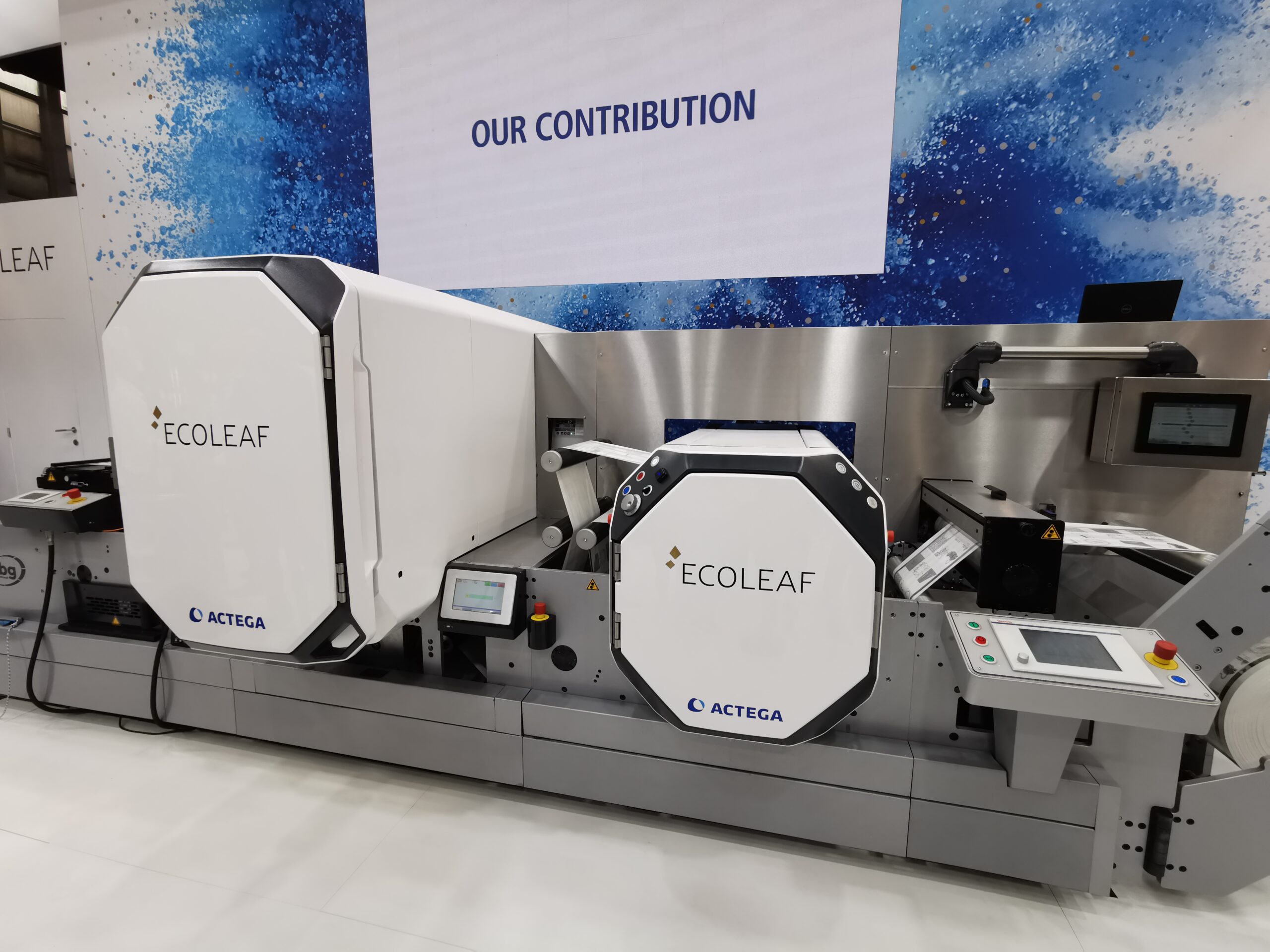
Ecoleaf roll-to-roll embellishment line with inkjet imaging
Traditional processes are advancing as well. Leading foiling supplier Kurz is aiming at improving the environmental footprint of foils by drastically reducing the thickness of the carrier materials (from 12 μm to 10 μm in hot-foil and even down to 6 μm in cold-foil) and setting up recycling factories for rolls of used foils.
Finishing
Unfortunately, there were too many finishing exhibits to mention or even to survey with finishing not getting the attention it deserves – again.
MGI’s Octopus finishing system was presented at the Konica Minolta booth for the first time at a major show. The Octopus is a flexible web cutting device, using a set of nine rotating knives. As three lanes of labels on the web are processed in parallel, each knife cuts the contours of every third label. I recommend watching a video of the cutting process. For now, the Octopus runs at 20 m/min, which is planned to increase to 30 m/min by the end of the year. The web width is 420 mm. The big advantages compared to laser cutting are a much lower energy consumption and no high heat on the substrate or burnt edges. The Octopus can be ordered now and is expected to start shipping in Q4.
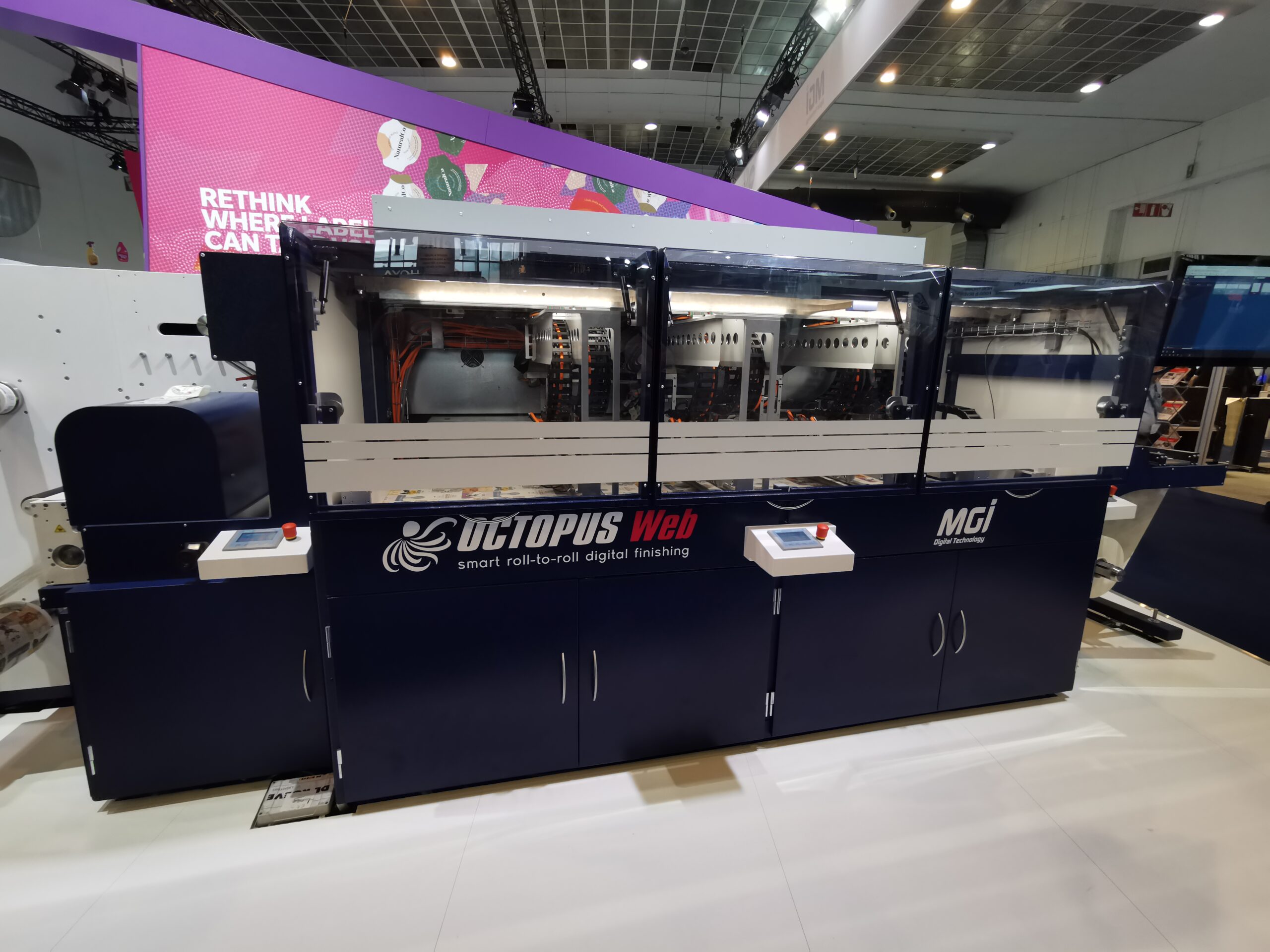
MGI Octopus
In contrast, the interest in laser cutting seems to have waned a bit, with not as many exhibits as expected. Remarkable however was SEI-Laser’s integration of an inkjet print engine into a laser cutting line, which I covered in the first part of this article.
Inks
A lot of pressure is mounting on packaging print, based on recent environmental legislation aiming at a circular economy and the reduction of hazardous substances. The EU is leading the charge but other countries or regions are already following suit or are likely to do so in the future.
As a result, Bobst will introduce a new UV ink set early next year, with the new inks not using TPO photoinitiators. Another announcement by Durst at Labelexpo was on ink developments. By moving to the new Tau RSC LED inks a significant reduction of energy consumption is achieved, which should yield 30 to 35% less energy according to Durst. Durst has also unveiled the new Tau RSC UV Ink 3 ink-set, which the company calls “Future Proof.” They are TPO-free, mineral oil- and PFAS-free, and have no heavy metals or VOCs
Not specifically targeted at inkjet, but rather flexo print is the Evolution Primer Flint Ink is working on. The primer dissolves in the deinking process, releasing the ink layer. The EU packaging waste regulation is going to require high-quality recyclates (clear or uncoloured), for which deinking will play a crucial role. So far Flint Ink is still testing material and deinking set-ups, but the first results are encouraging.
Preparing for the future
Although label printing is one of the more prosperous and moderately growing printing segments, the forces of cost-cutting and consolidation are present as well. Accordingly, efficiency and automation were themes on many booths. Automation is also driven by the lack of personnel and the desire to cut human interaction to improve productivity. Digital print can be a driver for efficiency, especially for short runs and less waste, a reason why digital presses were widely present.
Sustainability played an important role and is a background driver in many developments. Obvious examples are new ink sets, linerless label materials (e.g. from Avery Dennison), a move to LED UV curing, reducing material thickness (e.g. Kurz foils), or a shift away from foiling completely (Actega’s Ecoleaf). Some is caused by legislation but a lot will be driven by the brands, wanting to become more sustainable. FINAT, the European association for the self-adhesive label industry, is working on a carbon footprint calculator, which should help printers provide crucial sustainability data to their customers. The program seems a bit late, as only a general educational leaflet is available now, while providing carbon data will be mandatory in the EU by 2025.
A good number of Chinese inkjet label printer manufacturers exhibited, complemented by manufacturers from Korea and India. However, getting detailed information beyond a spec sheet proved to be difficult from the Chinese vendors. Many put up a sign as well according to which they were looking for distributors. Even if the devices are sound, a successful press installation is so much more than a piece of hardware, therefore it is very difficult to gauge the opportunities for these devices.
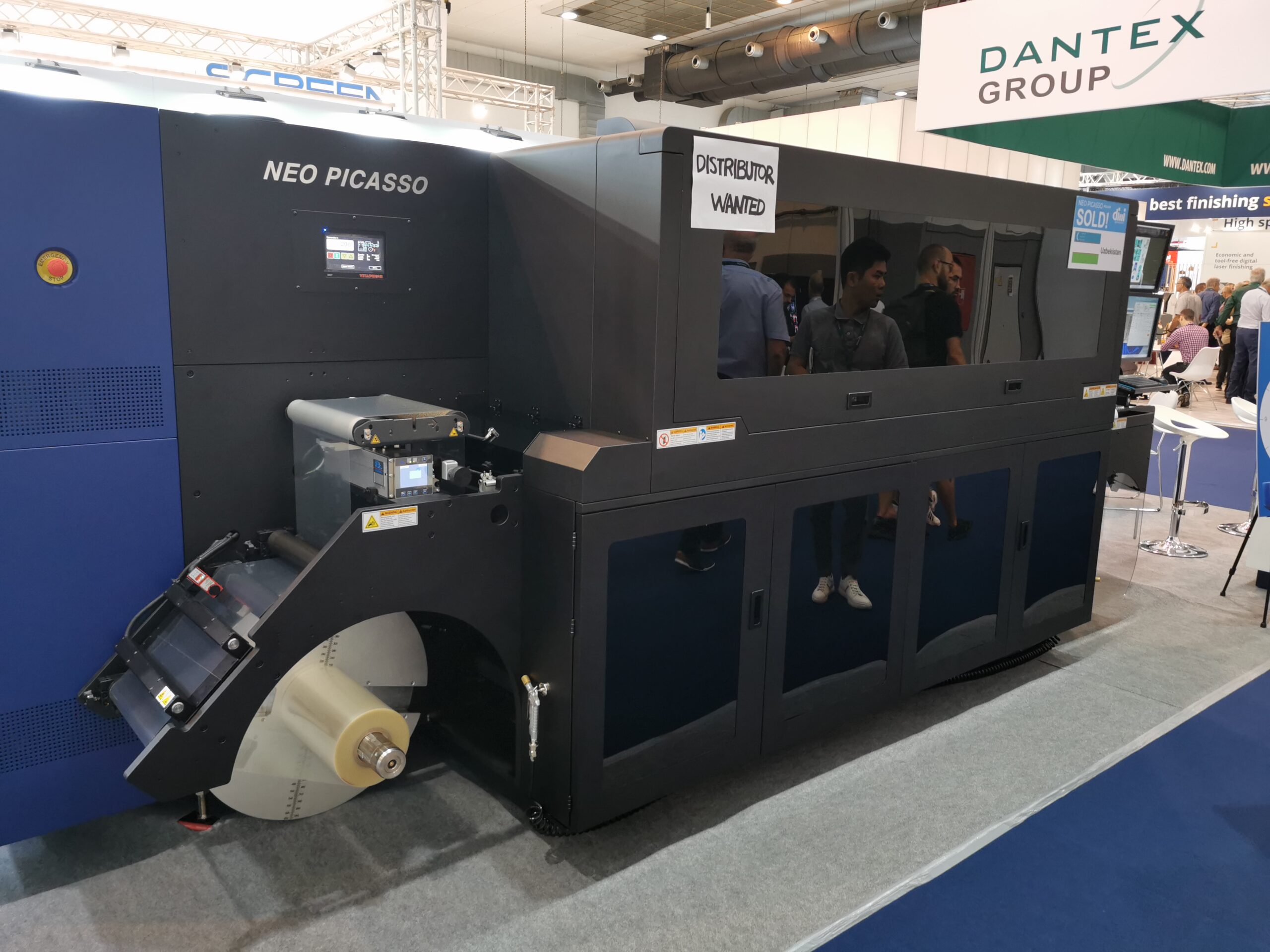
Dilli from Korea showing the Neo Picasso at LabelExpo
LabelExpo retains its position as the leading exhibition for the label market after the four-year break caused by the pandemic. It remains a show where manufacturers set up working lines of their top-of-the-line heavy metal equipment and prospects can have a direct look at tit printing. The current insecurity in the printing industry, caused by high production costs, softening demand, and a raft of new regulations, led to a somewhat lower visitor traffic than expected, nevertheless.
The next iteration of LabelExpo will be held in Barcelona in two years, at the new fairground. While Barcelona is an attractive city, it is not as central as Brussels, where many visitors are able to arrive by car or train. At least it can be expected that the new fairground will have better air conditioning, which made visiting the Brussels fairground on the first day almost unbearable.

